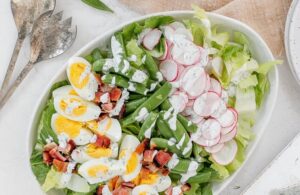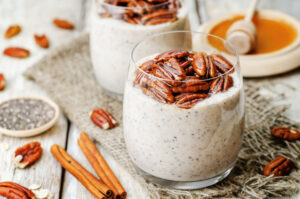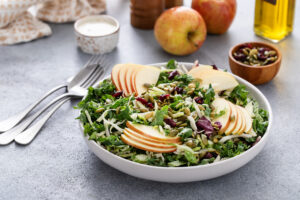Prep: 5 mins Wait: 7 hours 55 mins Total: 8 hours
These Cinnamon Roll Overnight Oats are perfect for a quick, grab-and-go breakfast. Creamy oats soak overnight in non-dairy milk and are flavored with brown sugar, vanilla, and cinnamon for that cozy, cinnamon roll taste.
Why You’ll Love This Recipe
- Healthier Indulgence: With cinnamon roll flavors, this recipe offers a satisfying taste without the high sugar and fat content typically found in traditional pastries.
- No Cooking Required: The overnight soaking process softens the oats, eliminating the need for cooking and simplifying the morning routine.
- Nutrient-Rich Ingredients: Made with old-fashioned rolled oats and unsweetened non-dairy milk, this breakfast provides fiber, calcium, and magnesium, contributing to a balanced diet.
Ingredients
- 2 ½ cups of unsweetened, non-dairy milk
- 2 ½ cups of old-fashioned rolled oats
- 1 ¼ tsp of vanilla extract
- 6 tsp of light brown sugar
- 1 ¼ tsp of ground cinnamon
Directions
Mix It All Together
- In a large bowl, combine 2 ½ cups of rolled oats with 2 ½ cups of your favorite non-dairy milk. Stir in 6 teaspoons of brown sugar, 1 ¼ teaspoons of vanilla extract, 1 ¼ teaspoons of cinnamon, and ½ teaspoon of salt until everything is well blended.
Portion It Out
- Evenly divide the mixture into five 8-ounce jars or containers. This makes it easy to grab a serving each day.
Relax and Let the Magic Happen
- Seal the jars with lids and place them in the fridge. Let them sit overnight—or store them for up to 5 days—for a ready-to-eat breakfast whenever you need it.
Nutritional Information
SOURCE: Cinnamon-Roll Overnight Oats
Prep: 15 mins Cook: 15 mins Total: 30 mins
No need to wait for ‘burger night’ or firing up the grill to indulge in all the flavors of a classic burger. With a Burger Bowl and Special Sauce, you can satisfy that craving in under 30 minutes. The best part? You can customize it with whatever ingredients you have or prefer.
Why You’ll Love This Recipe
- Flavorful and Healthy – Packed with fresh veggies, lean protein, and a delicious homemade special sauce.
- Versatile Ingredients – You can adjust the ingredients to suit your preferences or what you have available.
- Kid-Friendly – A fun and easy meal the whole family will enjoy.
Ingredients
- 8 cups of leafy greens (your choice)
- Any burger toppings you may want like cheese, onions, pickles, tomatoes, or bacon
- 2 washed and dried sweet potatoes
- Salt and pepper for finishing touches
- 2 tbsp of no-sugar ketchup
- 2 tbsp of diced dill pickles
Directions
Making the Sweet Potato Wedges
- Preheat oven to 400 degrees Fahrenheit.
- Line a large baking sheet with parchment paper.
- Slice the sweet potatoes into 1/2-inch-thick pieces and spread them out evenly on the baking sheet.
- In a bowl combine garlic powder, chili powder, and avocado oil.
- Pour the mixture over the sweet potatoes and toss until they’re coated evenly.
- Bake sweet potatoes for 25-35 minutes (depending on their thickness).
- Flip the sweet potatoes halfway through baking time or when the bottom of the potatoes are crispy and brown.
Cooking the Meat
- Add the ground beef into a medium pan, over medium heat.
- Season with desired amount of salt and pepper.
- Break up the ground beef and cook until the pink is gone.
Making the Special Sauce:
- In a medium-sized bowl combine the mayonnaise, no-sugar ketchup, diced pickles, Dijon mustard, white vinegar, onion powder, and desired amount of salt and pepper.
- Stir until all ingredients are mixed together.
Putting Together the Burger Bowl
- Put 2 cups of your leafy greens into each bowl.
- Top with ground beef and your desired burger toppings.
- Put sweet potato wedges on the side.
- Drizzle the special sauce over the bowl.
- Serve and enjoy this delicious meal.
Nutritional Information
- Serving Size: 1/4 of recipe
SOURCE: Burger Bowl with Special Sauce – The Real Food Dietitians
Prep: 10 mins Cook: 25 mins Total: 35 mins
This chicken pasta is a celebration of bold, fresh flavors. Juicy, golden-seared chicken breast pairs perfectly with tender, sautéed spinach in a bright, garlicky lemon sauce that’s as comforting as it is irresistible. Topped with a bit of Parmesan, this dish is a weeknight game-changer that’s so good that your family will be lining up for seconds. Simple, satisfying, and bursting with flavor—what’s not to love?
Why You’ll Love This Recipe
- Comforting and Light: You get all the creamy goodness of pasta with none of the heaviness. The dish is lightened up with spinach and a light lemon sauce, so you can enjoy a comforting meal without feeling weighed down. Plus, the Parmesan adds just the right amount of indulgence without being over-the-top.
- One-Skillet Wonder: Who doesn’t love fewer dishes? This recipe is all made in one skillet, so cleanup is a breeze. Plus, the sauce is absorbed by the pasta, so every bite is flavorful and satisfying.
- Flavor-Packed: Combining garlicky, lemony sauce, tender seared chicken, and vibrant sautéed spinach creates a harmonious burst of fresh, bold flavors. The zesty lemon balances out the richness of Parmesan, giving every bite the perfect amount of brightness and depth.
Ingredients
- 1 lb of boneless, skinless chicken breast cut into bite-sized pieces
- 8 oz of whole-wheat penne pasta (or pasta of your choice)
- 2 tbsp of extra-virgin olive oil
- 4 cloves of minced garlic
- 10 cups of chopped fresh spinach
- 1/3 cup of cubed unsalted butter
- 4 tbsp of grated parmesan
Directions
Cook the Pasta:
- In a large pot, bring salted water to a boil and cook the pasta until al dente.
- Drain, reserving ½ cup of pasta water.
Cook the Chicken:
- Heat olive oil in a large skillet over medium heat.
- Add the chicken, seasoning with salt and pepper, and cook until golden brown and fully cooked (about 7 minutes).
- Remove from the skillet and set aside.
Making the Sauce:
- In the same skillet, sauté garlic until fragrant, about 30 seconds.
- Pour in the wine and bring it to a simmer for 3-5 minutes, reducing it slightly.
Combine the Pasta and Chicken:
- In the same skillet, stir in the lemon zest, lemon juice, and butter.
- Add the pasta and chicken back into the skillet.
- Toss everything together, adding reserved pasta water if needed to help create a smooth sauce.
Finish with Spinach and Parmesan
- Stir in the chopped spinach and cook until wilted (about 5 mins).
- Finish by stirring in Parmesan cheese and seasoning to taste.
- Serve immediately, topped with more Parmesan if desired.
Nutritional Information
SOURCE: Chicken & Spinach Skillet Pasta with Lemon & Parmesan
Prep: 10 mins Cook: 20 mins Total: 30 mins
This week, we’re diving into a recipe that combines the best seasonal flavors: Harvest Chicken Salad! This salad is a crowd-pleaser loaded with textures and tastes that scream comfort and health, perfect for lunch meal prep, a light dinner, or a dish to impress at your next potluck.
Why You’ll Love This Recipe
- Nutritious and Satisfying: Packed with lean protein, fresh produce, and healthy fats, this salad is as good for your body as it is for your taste buds.
- Bursting with Flavors: A mix of sweet, savory, and nutty ingredients come together to create an unforgettable dish.
- Customizable: Swap ingredients to suit your dietary preferences or what you have on hand.
Salad Ingredients
- 1 cup of small diced red onions
- 1 peeled medium sweet potato diced into 1-inch pieces
- 1 lb raw chicken breast, cubed
- 5 large handfuls fresh spinach
- 1/3 cup dried cranberries
- 1/2 cup chopped, toasted walnuts
- 1/4 teaspoon black pepper
Dressing Ingredients
- 1 1/2 tablespoon Dijon mustard
- 3 tablespoons avocado oil
- 3 tablespoons pure maple syrup
- 1 teaspoon apple cider vinegar
- 1/4 teaspoon black pepper
Directions
Vegetables:
- Preheat your oven to 375°F (190°C).
- Combine the diced sweet potato and red onion on a baking sheet. Drizzle with 1 teaspoon of avocado oil, season with salt and pepper, and toss to ensure an even coating.
- Spread the vegetables in a single layer and roast for 15-18 minutes – or until tender and lightly browned.
- When finished roasting, remove the baking sheet and let sit for a few minutes.
Cook the Chicken:
- While the vegetables are roasting, heat the remaining 1 teaspoon of avocado oil in a skillet over medium-high heat.
- Add the cubed chicken to the skillet, cooking for approximately 3-5 minutes on each side or until the internal temperature reaches 165°F (74°C).
- Once cooked, remove the chicken from the heat and set aside.
Preparing the Dressing:
- In a small bowl or jar, whisk together the mayonnaise, avocado oil, pure maple syrup, Dijon mustard, apple cider vinegar, salt, and black pepper until smooth and well combined. Set aside.
Assembling the Salad:
- In a large mixing bowl, combine the fresh spinach, dried cranberries, diced apple, and toasted walnuts.
- Add the roasted sweet potatoes, red onion, and cooked chicken to the bowl.
- Pour the prepared dressing over the salad ingredients and gently toss everything together until all components are evenly coated with the dressing.
Serve:
- Divide the salad among 6 plates or bowls.
- Enjoy immediately while the roasted vegetables and chicken are still warm, or refrigerate and serve chilled if preferred.
- This salad can be stored for up to 4 days.
Nutritional Information
- Serving Size: 1/6 of the salad
SOURCE: Harvest Chicken Salad
Written by Jenna Adams, MFN, RD, LD & Heather Fowler, RDN, LD
Want to get a jumpstart on your health before the new year sets in? Want to learn how to manage your health during the holidays while still being able to enjoy your favorite seasonal foods? Food is a big part of the holidays, and it can be challenging to stay on track, but GemCare Wellness’ Diabetes Prevention Program (DPP) can help you learn and implement lasting lifestyle changes to improve your health and delay or prevent type 2 diabetes.
Our free-of-charge*, virtual Diabetes Prevention Program is open to anyone who has been diagnosed with prediabetes or who is at risk for developing type 2 diabetes (T2). Losing 5-7% of your body weight and getting at least 150 minutes of physical activity each week can lower your risk for developing type 2 diabetes by 58%, and if you are 60 or older, you can lower your risk by 71%.1
DPP classes provide you with knowledge and tools to navigate not only the holidays but each day successfully. You’ll learn how to incorporate the tools you learn in this program into lifelong, lasting change. Here are a few tips to get you started:
- Have a light meal or snack before a holiday event to help control your appetite.
- Bring a healthy option, such as a veggie or fruit tray.
- Hold a glass of water to stay hydrated and prevent grazing.
- Scope out the selections at family meals and prioritize your favorites, forgoing those you could do without.
- Select a moderate portion of the dessert that appeals most to you.
- Plan for fun family activities indoors or outdoors, such as going for a walk, playing board games, or having a snowball fight.
Topics we will cover throughout the year include how to eat to prevent type 2 diabetes, shop and cook, manage stress, take charge of your thoughts, and stay motivated. With weekly classes in the first sixth months of the program, you’ll find the needed support to help you navigate the holiday season. Join now, end the year strong, and start 2021 one step closer to your health and wellness goals!

*Program free of charge to participants. Funded by the Ohio Department of Health.
Sources:
- “About Prediabetes & Type 2 Diabetes.” National Diabetes Prevention Program, Centers for Disease Control and Prevention, Apr. 2019, cdc.gov/diabetes/prevention/about-prediabetes.html.
While food choices cannot prevent a breast cancer diagnosis, a nutritious diet and healthy lifestyle can help reduce risk
by Chelsea Jackle, RD
 Did you know that 1 in 8 women in the United States will develop breast cancer during her lifetime? (1) These odds may seem grim, but you should also know that survivorship has increased over the past several decades. (2) Better early detection and treatment are part of this improved outlook, but another important piece to the survivorship puzzle is prevention.
Did you know that 1 in 8 women in the United States will develop breast cancer during her lifetime? (1) These odds may seem grim, but you should also know that survivorship has increased over the past several decades. (2) Better early detection and treatment are part of this improved outlook, but another important piece to the survivorship puzzle is prevention.
In addition to regular self-breast exams, mammograms, and follow-ups with your doctor to detect cancer early, being aware of lifestyle and nutrition changes that reduce your breast cancer risk is key. While no food or diet can prevent any cancer, eating a nutritious diet and living a healthy lifestyle can give you a better chance of reducing your risk.
There are many different types of cancer, all involving a variety of tissues and areas of the body. These differences impact how the disease behaves and how risk factors will affect it. For example, breast tissue is sensitive to changes in hormone levels (like estrogen), and this is especially true in cancer. Tumor growth is often affected by hormone levels. As most ladies know, your hormone levels change throughout each stage of life (and even within a month). This information on hormones will come in handy later.
Researchers are always studying how our diets, activity levels, and lifestyles affect cancer risk and survivorship. One of the largest ongoing projects on this topic is the Continuous Update Project (also known as CUP) from the World Cancer Research Fund. After analyzing many studies and looking for the strongest evidence available, the experts involved in this project identified a list of key factors that can impact your overall cancer risk. (2)
Foods to Include to Reduce Cancer Risk
Fruits and Vegetables
We’ve all heard that we should be eating more fruits and vegetables, but it may help to understand why experts emphasize the recommendation, especially when it comes to cancer risk.
Eating non-starchy vegetables can decrease the risk of a specific kind of breast cancer called ER- (or estrogen-receptor-negative). (2) Non-starchy vegetables include broccoli, cauliflower, cabbage, tomatoes, asparagus, green beans, brussels sprouts, leafy greens, onions, and so many more!
Fruits, vegetables, and other plant foods like whole grains and beans contain special compounds called phytochemicals. These compounds have some long, fancy-sounding names (glucosinolates, isoflavones, and polyphenols… oh my!), but what you really need to know is that different foods have different amounts of phytochemicals, and they all play different roles, which makes it important to mix up the plant foods you eat. When you eat a variety of foods you get a variety of cancer-fighting phytochemicals.
According to the CUP research, an important family of phytochemical for reducing your breast cancer risk is the carotenoids. (2) If you’re thinking to yourself, “that word kind of reminds me of carrots,” you’re right! Carotenoids are found in carrots, but they are also found in other fruits and vegetables like cooked tomatoes, broccoli, leafy greens, winter squash, sweet potatoes, watermelon, apricots, oranges, and cantaloupe.
Soy Foods
Soy always seems to stir up controversy. Does it help? Does it hurt? According to the CUP project, breast cancer survivors who ate soy foods saw better survival rates!
The controversy around soy has to do with phytochemicals in soy called isoflavones, which are plant forms of the hormone estrogen. (See, I told you hormones were going to come up again!) Since high estrogen levels in the body have been linked to a higher risk of breast cancer, some believe that the plant estrogen in soy is harmful. Some of this belief also comes from studies where rats were given very high doses of isoflavones and saw increased cancer rates.
However, the isoflavone levels we get from real food are much smaller than this, and humans are not the same as rats! Current evidence in humans has not shown a link between soy foods and breast cancer risk. (3) Generally, 1-3 servings from whole food sources like tofu, edamame, miso, tempeh, and soy milk is recommended.
Calcium-Rich Foods
The CUP project concluded that diets rich in calcium decrease breast cancer risk. (2) High-calcium foods include dairy products like milk, yogurt, and cheese, as well as fortified non-dairy alternatives. This research project also found that dairy intake can reduce the risk of pre-menopausal breast cancer. (2)
Other Lifestyle Modifications to Consider
Limit or Abstain from Alcohol
Consuming alcohol increases breast cancer risk as well as the risk for other cancers (colorectal, stomach, liver). The risk increases the more someone drinks. (2)
Maintain a Healthy Weight
Being in the overweight or obese categories for Body Mass Index (BMI, which can be used to screen for health problems, but in itself is not diagnostic of an individual’s health) decreases the risk of pre-menopausal breast cancer, but being in these weight categories during adulthood can increase the risk of post-menopausal breast cancer. Weight gain that happens in adulthood can also be a risk factor. (2) The key here is maintaining a healthy weight long-term.
Include Physical Activity
Evidence strongly suggests that vigorous physical activity (any activity that elevates your heart rate to 70–80% of your maximum heartrate) can decrease your risk of breast cancer, but any amount of physical activity can be helpful and may also reduce your cancer risk. (2, 4)
Key Takeaways
- Eat non-starchy vegetables and a variety of plant-based foods
- Include fruit and vegetables that contain carotenoids
- Include calcium-rich foods like dairy or dairy-alternatives
- Limit or exclude alcoholic beverages
- Maintain a healthy weight
- Stay active and include vigorous physical activity if possible
Following the World Cancer Research Fund guidelines has been shown to lower the risk of developing many cancers, including breast cancer. (5) Knowing these guidelines is one thing, but implementing them can be a challenge. Our team of registered dietitians is here to help you make lasting lifestyle changes to improve your health. Book a consultation today: https://www.gemcarewellness.com/nutravantage-request-a-call/
References:
- https://www.nationalbreastcancer.org/breast-cancer-facts
- https://www.wcrf.org/dietandcancer/breast-cancer
- https://www.cancer.org/latest-news/soy-and-cancer-risk-our-experts-advice.html
- https://www.heart.org/en/healthy-living/fitness/fitness-basics/target-heart-rates
- https://academic.oup.com/ajcn/article/96/1/150/4571421







